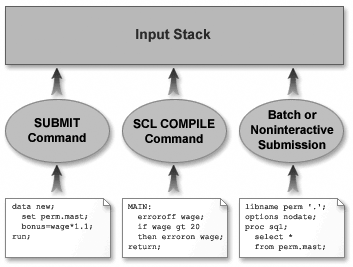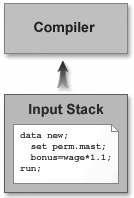Processing Macro Variables
SAS Processing
You
have seen how to create and reference macro variables. In order to
work with macro variables in the programs that you write, you need
to understand how macro variables are processed and stored. First,
it is important that you understand how SAS processing works.
A SAS program can be
any combination of the following:
-
DATA steps and PROC steps
-
global statements
-
SAS Component Language (SCL) code
-
Structured Query Language (SQL) code
-
SAS macro language code.
When you submit a program,
it goes to an area of memory called the input stack. This is true
for all code that you submit, such as a DATA step, SCL code, or SQL
code.
Once SAS code is in
the input stack, SAS
-
reads the text in the input stack (left-to-right, top-to-bottom)
-
routes text to the appropriate compiler upon demand
-
suspends this activity when a step boundary such as a RUN statement is reached
-
executes the compiled code if there are no compilation errors
-
repeats this process for any subsequent steps.
Tokenization
Between the input stack and the compiler,
SAS programs are tokenized into smaller pieces. A component of SAS
known as the word scanner divides program text into fundamental units
called tokens.
-
Tokens are passed on demand to the compiler.
-
The compiler requests tokens until it receives a semicolon.
-
The compiler performs a syntax check on the statement.
SAS stops sending statements
to the compiler when it reaches a step boundary. Examples of step
boundaries include a RUN statement (
run;)
or the beginning of a new DATA or PROC step. Once the entire step
has been compiled, it is executed.
The word scanner recognizes
four types of tokens:
-
A literal token is a string of characters that are treated as a unit. The string is enclosed in either single or double quotation marks.Examples:
"Any text" 'Any text' -
A number token is a string of numerals that can include a period or E notation (real numbers). Date constants, time constants, datetime constants, and hexadecimal constants are also number tokens.Examples:
23 109 '01jan2002'd 5e8 42.7 -
A name token is a string of characters that begins with a letter or underscore and that continues with underscores, letters, or digits. A period can sometimes be part of a name.Examples:
infile _n_ item3 univariate dollar10.2 -
A special token is any character or group of characters that has a reserved meaning to the compiler.Examples:
* / + - ** ; $ ( ) . & %
A token ends when the
word scanner detects
-
the beginning of another token
-
a blank after a token.
The maximum length of
any token is 32,767 characters.
Macro Triggers
Macro variable references and
%LET statements are part of the macro language. The macro facility
includes a macro processor that is responsible for handling all macro
language elements. Certain token sequences, known as macro triggers,
alert the word scanner that the subsequent code should be sent to
the macro processor.
The word scanner recognizes
the following token sequences as macro triggers:
-
% followed immediately by a name token (such as %let)
-
& followed immediately by a name token (such as &amt).
When a macro trigger
is detected, the word scanner passes it to the macro processor for
evaluation. The macro processor
-
examines these tokens
-
requests additional tokens as necessary
-
performs the action indicated.
For macro variables,
the processor does one of the following:
-
creates a macro variable in the symbol table and assigns a value to the variable
-
changes the value of an existing macro variable in the symbol table
-
looks up an existing macro variable in the symbol table and returns the variable's value to the input stack in place of the original reference.
The word scanner then
resumes processing tokens from the input stack.
Note: The word scanner does not recognize
macro triggers that are enclosed in single quotation marks. Remember
that if you need to reference a macro variable within a literal token,
such as the title text in a TITLE statement, you must enclose the
text string in double quotation marks or the macro variable reference
is not resolved.
..................Content has been hidden....................
You can't read the all page of ebook, please click here login for view all page.



